A guide to some of NC’s most dangerous plants, from poison ivy to hemlock & horse nettle
North Carolina’s poisonous plants, which can also be called “toxic plants,” are sometimes dangerous to touch and can react with your skin as a chemical burn. Others are fine to touch (and may even be planted in your yard), but you’ll get into real trouble if you ingest them.
The News & Observer spoke about these plants with Ainsley Briggs, herb garden curator at the North Carolina Botanical Garden, which includes the garden’s poisonous plants collection.
“There are over 650 poisonous plants in our area, so you can get exhaustive with creating these kinds of lists,” Briggs said.
So we put together a list of the most common poisonous plants you can encounter, including plants poisonous to the touch and poisonous to ingest.
To get more information on poisonous plants — and to see the full database of plants — spend some time at plants.ces.ncsu.edu.
Note: If you think you’ve come in contact with a poisonous plant and need help, call NC Poison Control at 1-800-222-1222.
Here are plants with which you should make yourself familiar:
Poison ivy vs. poison oak vs. sumac: How to tell the difference
Poison ivy and poison oak are the most common around the Triangle, Briggs said, while sumac is in much wetter areas, such as the coastal plains and mountain bogs.
An oily chemical is what makes the plant poisonous. Washing yourself immediately after going on hikes and doing yard work can help get rid of the oily substance, which has the consistency of motor oil but is invisible.
It’s not just about using soap and water, but using friction and rubbing yourself to get the chemical totally off.
Poison ivy and poison oak can be found in yards and on hikes. They are high-priority plants for park rangers to manage, so if you see any on or bordering hiking trails, it just means rangers haven’t come to remove them yet.
Learn what these plants look like so you can avoid them, as they’re extremely common to encounter.
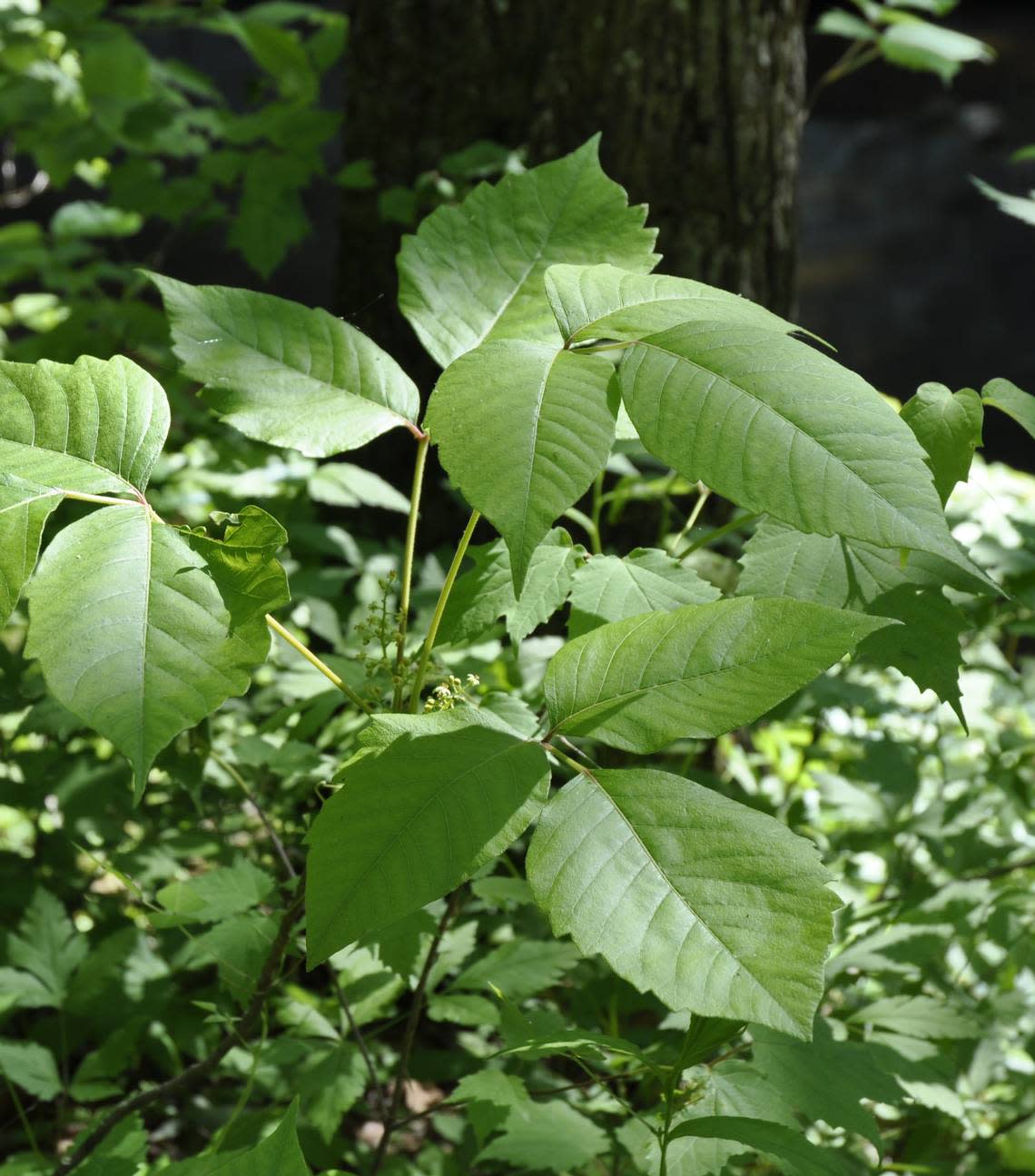
What does poison ivy look like?
Poison ivy can grow as a vine or a small shrub, trailing along the ground or even climbing low plants, trees and poles. Look for three glossy leaflets.
The common expression is “leaves of three, let it be.”
Here’s what NC State Extension teaches:
Common names: Eastern Poison Ivy, Poison Ivy, Poison Oak
Appearance: The signature three leaflets are often pointed with a notch on the edge. The sets of three leaflets are never directly opposite each other on the vine.
Color: Leaves emerge with a shiny reddish tinge in the spring and turn a dull green as they age, eventually turning shades of red or purple in the fall before dropping.
Leaf length: Three to six inches
Leaf width: One to three inches
Stem: The middle leaflet has a short stem and is longer than the outer two. Leaflets can be up to six inches long. They may be toothed or have smooth edges.
Flowers, berries: Possibly greenish-white flowers and whitish-yellow berries.
Source: plants.ces.ncsu.edu/plants/toxicodendron-radicans
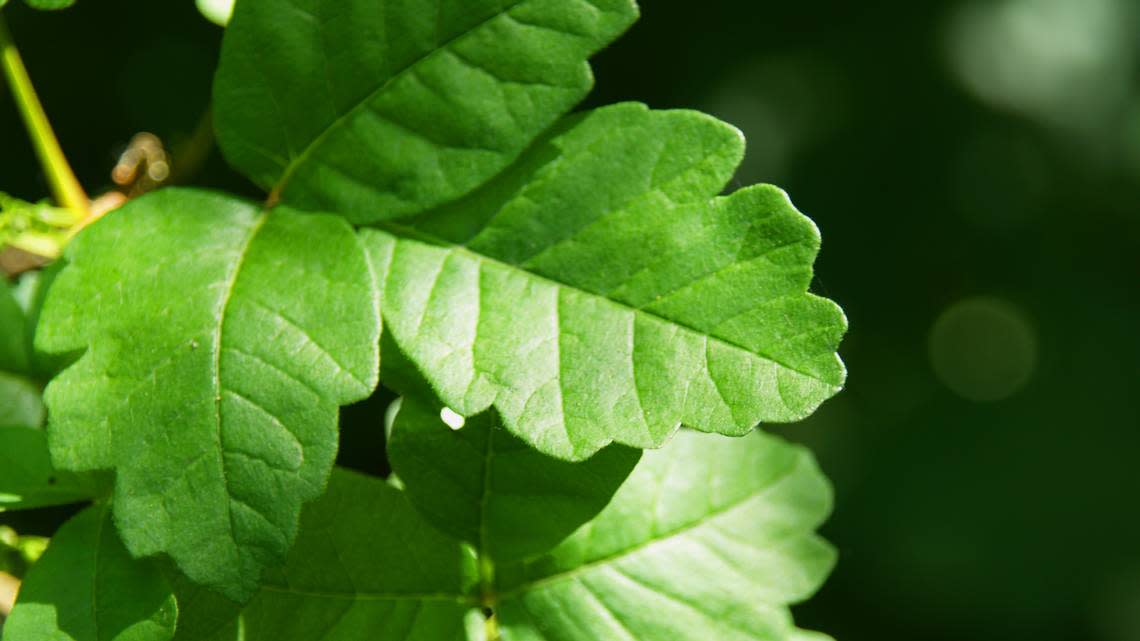
What does poison oak look like?
Poison oak is a vertical, low-growing shrub. They can grow up to 10 feet tall but usually grow two to four feet tall. They’re found in dry areas and also have three leaflets.
Here’s what NC State Extension teaches:
Common names: Atlantic Poison Oak, Eastern Poison Oak, Poison Oak
Appearance: Leaves appear alternately and in threes. The leaf shape is elliptic. They may be lobed or have toothed margins.
Color, texture: The leaves are typically leathery in texture, appearing dark green to yellowish-green. They are typically covered in fine hair (also called “pubescent”) on both sides. In the fall, the leaves turn a vibrant reddish-orange.
Leaf length: Three to six inches
Leaf width: One to three inches
Stem: The stems are slender, grayish-brown and slightly hairy. The buds are velvety in texture.
Flowers, berries: Blooms typically appear in spring, and small gold flowers are under one inch large. Tight clusters of greenish-white unripe berries appear in late spring. When ripened, they turn a tannish-white.
Source: plants.ces.ncsu.edu/plants/toxicodendron-pubescens
Common plants poisonous to touch in NC
Spotted water hemlock and giant hogweed are common to the Triangle and look very similar.
These plants are extremely toxic. Spotted Water Hemlock is internally poisonous (ingesting can be fatal), and giant hogweed is both internally and externally poisonous. Touching this plant can lead to severe chemical burns.
They all look very similar to Queen Anne’s lace, a common garden plant in the Triangle.

Spotted water hemlock: Appearance, location, dangers
Here’s what NC State Extension teaches:
Appearance: Water Hemlock has short, tuberous roots with purple-striped stems and clusters of small, white flowers.
Flowers: The tiny, white lowers form in umbrella-like clusters. They bloom from spring to fall, attracting a variety of bee, wasp and butterfly species.
Found in: Wet areas of forests and other natural areas.
Height: In its first year, it will be in the form of a low-growing rosette. Maturing in the second year, it will develop a tall stalk and can grow up to eight feet.
Dangers: It cannot be ingested, as it may be fatal if eaten. It can lead to delirium, nausea, convulsions, stomach pain, vomiting and seizures. This all typically occurs within an hour after ingestion.
Source: plants.ces.ncsu.edu/plants/cicuta-maculata
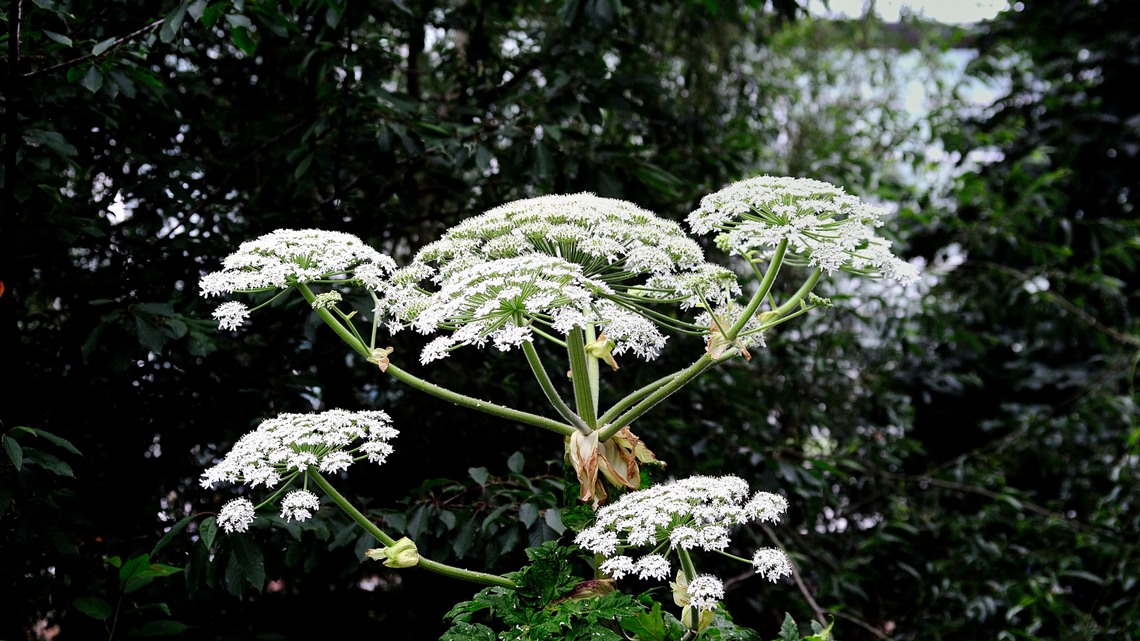
Giant hogweed: Appearance, location, dangers
Here’s what NC State Extension teaches:
Common names: Cartwheel-flower, Giant Cow Parsley, Giant Cow Parsnip, Giant Hogweed, Hogsbane
Appearance: Very similar to Spotted Water Hemlock (see above), though larger.
Flowers: Large, white, flat-topped flowers appear from June to July. Flower clusters can reach two and a half feet across.
Leaves: Very large, green leaves. The leaflets near the top of the stem are less cut-looking and not as large.
Found in: This plant prefers moist areas with some shade, particularly along stream banks.
Height: It is a very large plant and can be 20 feet tall.
Dangers: The sap of the plant is highly toxic and can cause sensitivity to UV rays. This can lead to severe blistering and burning from sun exposure.
Source: plants.ces.ncsu.edu/plants/heracleum-mantegazzianum
Common plants poisonous to eat, ingest in NC
Make yourself familiar with these three common plants, as ingestion can be fatal: aconitum, Carolina Jessamine and horse nettle.
Learn more about these three plants below.
Note: Many gorgeously flowering plants in front yards can also be toxic to eat, including azaleas and other rhododendrons, though they are rarely fatal. You can even get sick from the honey that bees make after pollinating these plants, Briggs said.
Holly berries can also make you very sick.
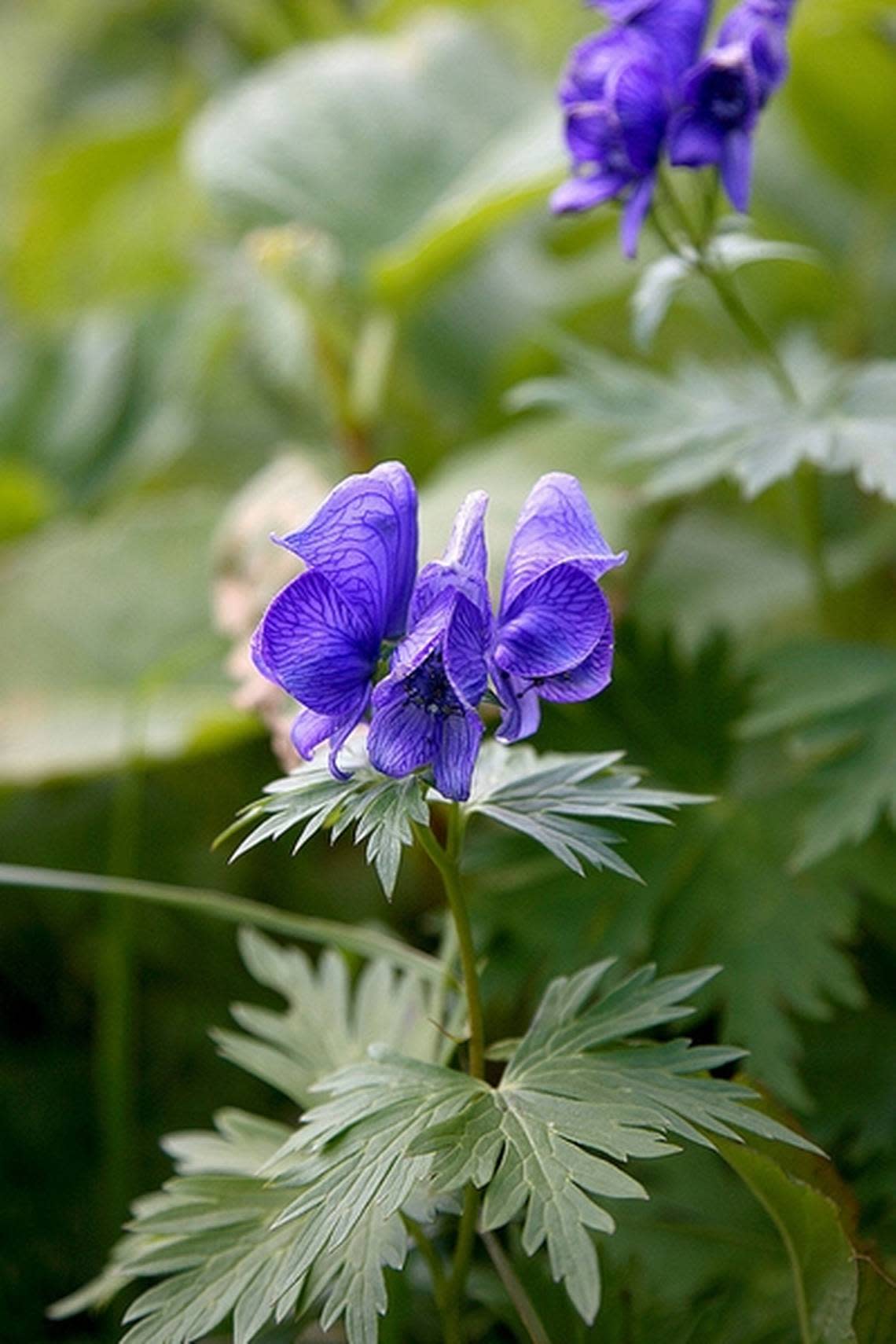
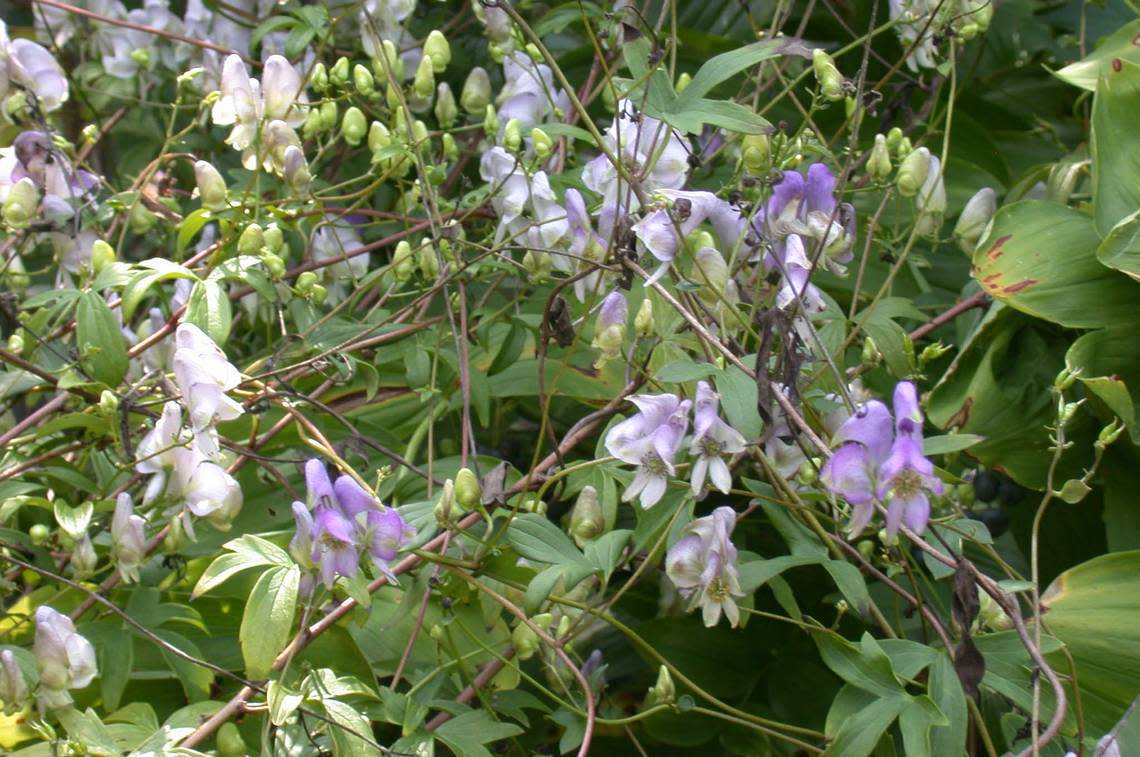
Aconitum: Appearance, location, dangers
Here’s what NC State Extension teaches:
Common names: Appalachian Blue Monkshood, Blue Rocket, Devil’s Helmet, Eastern Blue Monkshood, Eastern Monkshood, Monkshood, Southern Blue Monkshood, Wild Monkshood, Wolf’s Bane
Appearance: The plant has large, green leaves that often flop over. Flowers are purple or purplish-blue and look hooded.
Flowers: Flowers are white or blue-purple with the upper part appearing hooded. Purple flowers are clustered at the end of stems, and they bloom from August to October.
Leaves: The veined leaves can be nine-lobed with pointed tips. They are up to six inches large.
Found in: It can be found in the wild in low woods and damp slopes, thickets, wet areas along streams and in springs.
Height: Resembling a vine, it will send several arching stems upwards that will use surrounding plants for support. These slender stems can be five feet tall.
Dangers: Poisonous if ingested and may be fatal. One could experience burning of lips and mouth, numbness of throat, intense vomiting and diarrhea, muscular weakness and spasms, weak pulse, paralysis of the respiratory system, convulsions.
Source: plants.ces.ncsu.edu/plants/aconitum-uncinatum
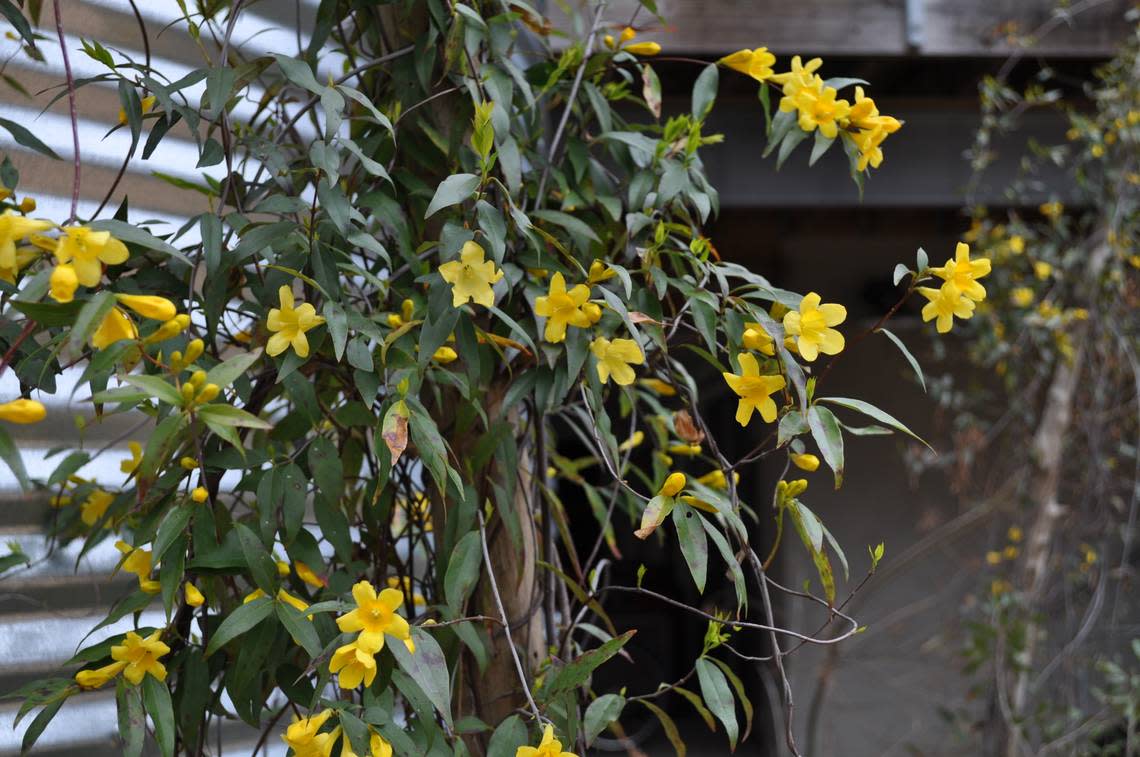
Carolina Jessamine: Appearance, location, dangers
Here’s what NC State Extension teaches:
Common names: Carolina Jasmine, Carolina Jessamine, Carolina Yellow Jessamine, Yellow Jessamine
Appearance: Admired for its sweetly scented, canary-yellow flowers and glossy evergreen foliage, this vine puts on a show from February to May. The foliage generally bronzes in winter.
Flowers: Bright, fragrant, funnel-shaped, yellow flowers (up to one and a half inches long) that appear either solitary or in clusters in late winter to early spring. This is typically February to May, depending on location, and sometimes blooming again in the fall.
Leaves: Shiny, lanceolate, light green leaves (up to three inches long), which are evergreen but may develop yellow to purple hues in winter.
Found in: Carolina Jessamine can be found in the wild in wooded areas and thickets growing up tree trunks. It can become weedy in disturbed areas and along roadsides.
Height: It can grow to 20 feet tall (if trained to an arbor or trellis) after three or four growing seasons. If unsupported, it creates a bushy ground cover.
Dangers: Poisonous if ingested and may be fatal. One could experience sweating, nausea, muscular weakness, dilated pupils, lowered temperature, convulsions, respiratory failure.
Source: plants.ces.ncsu.edu/plants/gelsemium-sempervirens
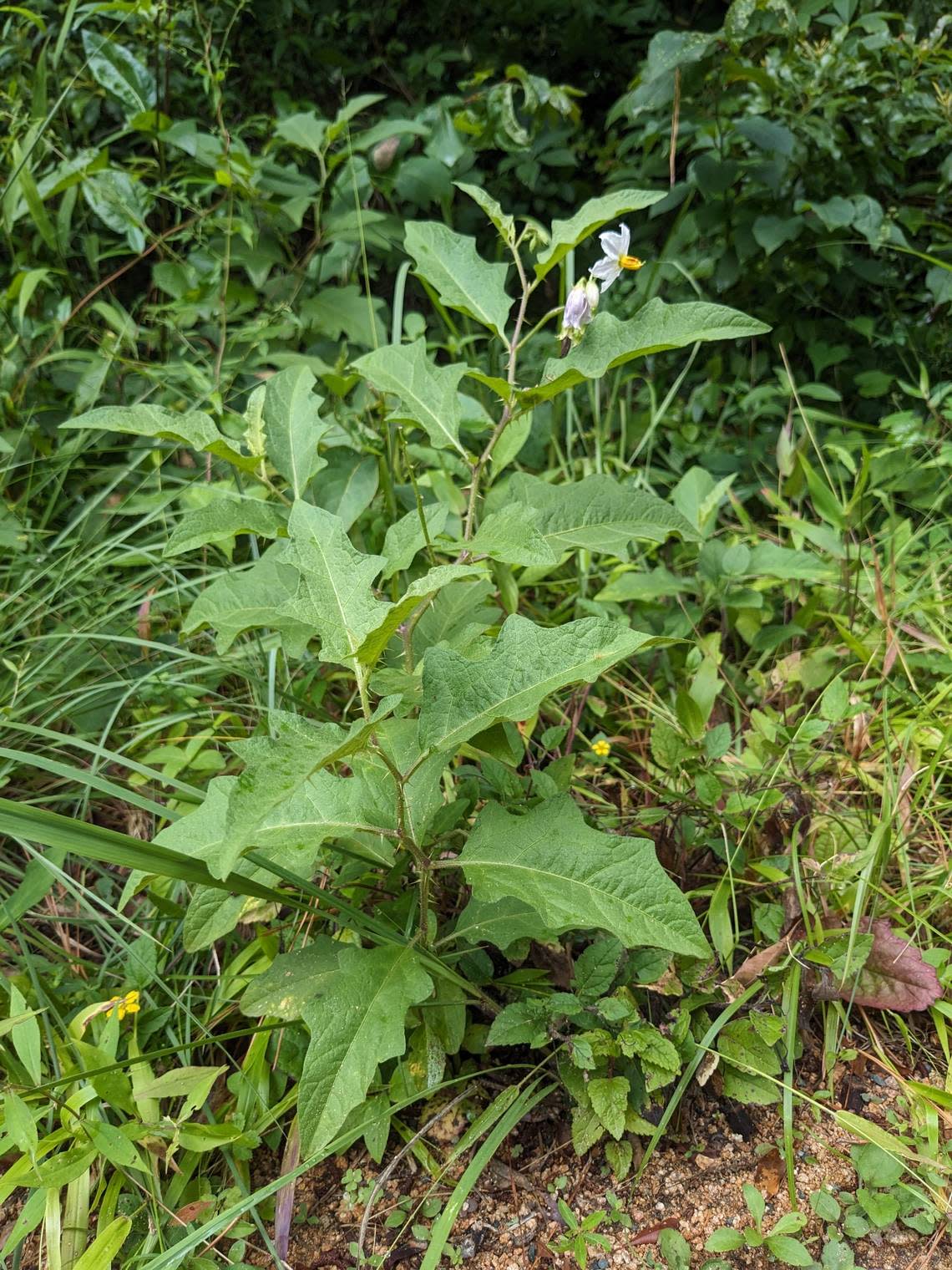
Horse nettle: Appearance, location, dangers
Here’s what NC State Extension teaches:
Common names: Apple of Sodom, Bull Nettle, Carolina Horse-Nettle, Devil’s Potato, Devil’s Tomato, Horsenettle, Horse Nettle, Poisonous Potato, Thorn Apple, Wild Tomato
Appearance: Horse nettle is a native, warm-season perennial herb that can grow either erect or sprawling. It has prickles along the stems and leaves. The plant is a member of the nightshade family, which also includes tomatoes, potatoes, eggplants, and peppers. It smells like a potato when the leaves are crushed.
Flowers: The light violet or white star-shaped flowers appear in the summer and fall. Its fruits are green berries that look like very small tomatoes. As the fruit ripens, it turns yellow and looks wrinkled.
Leaves: The leaves are alternate, oblong and covered on both sides with star-shaped hairs. The leaf measures two to six inches long and up to three inches wide. Leaf edges are frequently wavy.
Found in: Horse nettle prefers full sun and is tolerant to wet and dry conditions. They can grow in sandy or loamy soils. They can easily become weedy and aggressive in disturbed sites.
Height: It can grow up to four feet tall.
Dangers: Poisonous if ingested and may be fatal. One could experience nausea, vomiting, salivation, drowsiness, abdominal pain, diarrhea, weakness, respiratory depression, coma.
Source: plants.ces.ncsu.edu/plants/solanum-carolinense
Triangle Asked & Answered: What do you want to know?
Have a question about something in our community? The News & Observer’s Service Journalism team wants your questions for our Triangle Asked & Answered series. Reach out to us by filling out this form or by sending an email to ask@newsobserver.com.
6 NC spots made the annual Best Places to Live in the South list. Here’s why
3 North Carolina routes make the list of best summer road trips in the nation
